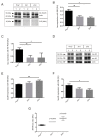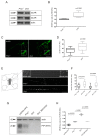Tau Exon 10 Inclusion by PrPC through Downregulating GSK3β Activity
- PMID: 34065232
- PMCID: PMC8161268
- DOI: 10.3390/ijms22105370
Tau Exon 10 Inclusion by PrPC through Downregulating GSK3β Activity
Abstract
Tau protein is largely responsible for tauopathies, including Alzheimer's disease (AD), where it accumulates in the brain as insoluble aggregates. Tau mRNA is regulated by alternative splicing, and inclusion or exclusion of exon 10 gives rise to the 3R and 4R isoforms respectively, whose balance is physiologically regulated. In this sense, one of the several factors that regulate alternative splicing of tau is GSK3β, whose activity is inhibited by the cellular prion protein (PrPC), which has different physiological functions in neuroprotection and neuronal differentiation. Moreover, a relationship between PrPC and tau expression levels has been reported during AD evolution. For this reason, in this study we aimed to analyze the role of PrPC and the implication of GSK3β in the regulation of tau exon 10 alternative splicing. We used AD human samples and mouse models of PrPC ablation and tau overexpression. In addition, we used primary neuronal cultures to develop functional studies. Our results revealed a paralleled association between PrPC expression and tau 4R isoforms in all models analyzed. In this sense, reduction or ablation of PrPC levels induces an increase in tau 3R/4R balance. More relevantly, our data points to GSK3β activity downstream from PrPC in this phenomenon. Our results indicate that PrPC plays a role in tau exon 10 inclusion through the inhibitory capacity of GSK3β.
Keywords: Alzheimer’s disease; GSK3β; alternative splicing; cellular prion protein; microtubule-associated protein tau; tauopathies.
Conflict of interest statement
The authors declare no conflict of interest.
Figures






Similar articles
-
The alternative splicing of tau exon 10 and its regulatory proteins CLK2 and TRA2-BETA1 changes in sporadic Alzheimer's disease.J Neurochem. 2006 Feb;96(3):635-44. doi: 10.1111/j.1471-4159.2005.03552.x. Epub 2005 Dec 20. J Neurochem. 2006. PMID: 16371011
-
Dysregulated coordination of MAPT exon 2 and exon 10 splicing underlies different tau pathologies in PSP and AD.Acta Neuropathol. 2022 Feb;143(2):225-243. doi: 10.1007/s00401-021-02392-2. Epub 2021 Dec 7. Acta Neuropathol. 2022. PMID: 34874463 Free PMC article.
-
Quantitative analysis of tau isoform transcripts in sporadic tauopathies.Brain Res Mol Brain Res. 2005 Jun 13;137(1-2):104-9. doi: 10.1016/j.molbrainres.2005.02.014. Epub 2005 Mar 29. Brain Res Mol Brain Res. 2005. PMID: 15950767
-
Alternative splicing of exon 10 in the tau gene as a target for treatment of tauopathies.BMC Neurosci. 2008 Dec 3;9 Suppl 2(Suppl 2):S10. doi: 10.1186/1471-2202-9-S2-S10. BMC Neurosci. 2008. PMID: 19090983 Free PMC article. Review.
-
Regulation of alternative splicing of tau exon 10.Neurosci Bull. 2014 Apr;30(2):367-77. doi: 10.1007/s12264-013-1411-2. Epub 2014 Mar 14. Neurosci Bull. 2014. PMID: 24627328 Free PMC article. Review.
Cited by
-
Alzheimer's disease is an inherent, natural part of human brain aging: an integrated perspective.Free Neuropathol. 2022 Jul 8;3:17. doi: 10.17879/freeneuropathology-2022-3806. eCollection 2022 Jan. Free Neuropathol. 2022. PMID: 37284149 Free PMC article.
-
GSK3: A potential target and pending issues for treatment of Alzheimer's disease.CNS Neurosci Ther. 2024 Jul;30(7):e14818. doi: 10.1111/cns.14818. CNS Neurosci Ther. 2024. PMID: 38946682 Free PMC article. Review.
References
-
- Lowe J., Kalaria R. Dementia. In: Love S., Budka H., Ironside J., Perry A., editors. Greenfield’s Neuropathology. 9th ed. CRC Press; Boca Raton, FL, USA: 2015. pp. 858–973.
MeSH terms
Substances
Grants and funding
- RTI2018-099773-B-I00/Spanish Ministry of Science, Innovation and Universities
- FPU15/02705/CERCA Programme, the Spanish Ministry of Education and Professional Formation
- SGR2017-648/Commission for Universities and Research of the Department of Innovation, Universities, and Enterprise of the Generalitat de Catalunya
- CMED2018-2/CIBERNED
- LCF/PR/HR19/52160007/"la Caixa" Foundation (ID 100010434)
LinkOut - more resources
Full Text Sources
Molecular Biology Databases
Research Materials

